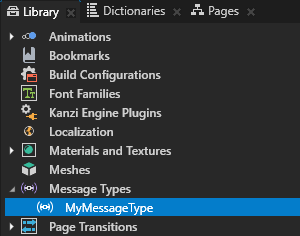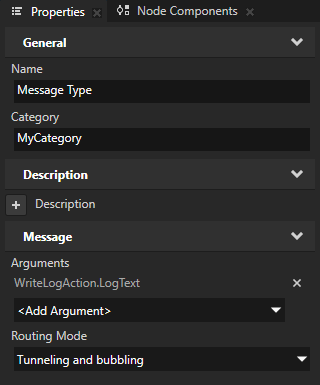Using messages¶
The message system provides a way to notify about events and to exchange information.
Messages and arguments¶
MessageArguments is the base class for arguments passed in messages. Kanzi provides built-in message types for different nodes and triggers. For example, the ButtonConcept::ClickedMessageArguments message for the Button: Click trigger and the Page::ActivatedMessageArguments message for the Page Activated trigger.
You can extend the MessageArguments class by writing your own message types.
Message type describes:
The nature of an event or information
For example,
ClickManipulator::ClickMessageandListBoxConcept::ItemSelectedMessage.Arguments to describe the data associated within the message
For example, the
HitTestPointPropertyandSelectedItemIndexPropertyproperties.
You can describe and access the message arguments with the PropertyType objects. MessageArguments::setArgument function sets and MessageArguments::getArgument function retrieves arguments with the underlying storage type for arguments, such as float, boolean, and vector3.
Creating custom messages in Kanzi Studio¶
To create a custom message in Kanzi Studio:
In the Library press Alt and right-click Message Types and select Message Type.

In the Properties set:
Category to the category where you want Kanzi Studio to show this message in context menus.
Arguments to the arguments accepted by the message type.
Routing Mode to the routing mode of the message type.
Tunneling mode passes the message through the outermost parent node of the recipient node.
Bubbling mode passes the message through the closest parent node of the recipient node.

Using messages in the Kanzi Engine API¶
Dispatching messages¶
To dispatch messages use Node::dispatchMessage. This function defines the message type and arguments and calls all the handlers and filters which are registered for the node for that message type. Node::dispatchMessage notifies the handlers and filters immediately before the function call returns, which enables the handlers and filters to react to the message immediately.
When you dispatch a message it travels in two phases: first tunneling, then bubbling. During the tunneling phase the message travels down the node tree from the first child node of the Screen node (the root node) to the node where the message originated. From there the message bubbles back up the node tree to the root node.
Reacting to messages¶
All messages in Kanzi are routed messages. When a message is dispatched, the system walks through the node tree from the first child node of the Screen node (the root node) to the source node of the message in a process called tunneling, and then walks back up the node tree to the root node in a process called bubbling. When you want nodes to react to a message when that message passes, add message handlers or filters to those nodes. A message filter intercepts messages from any node while a message handler listens only to messages from a specific source node.
At each passed node in the node tree the system looks for handlers and filters for the dispatched message. This allows you to install handlers and filters at any place in the node tree to intercept messages before they reach their destination, or to gather messages from several sources.
To register message handlers and filters that react to:
Bubbling messages use
Node::addMessageHandler()andNode::addMessageFilter()Tunneling messages use
Node::addTunnelingHandler()andNode::addTunnelingFilter()
To remove all types of handlers and filters use Node::removeMessageHandler().
To define a simple example node, one message type, two callbacks which are suitable for message handlers and a counting mechanism to verify the callback invocations:
// Counts how many times the callbacks are invoked to verify that the calls occur.
static int callCount = 0;
// Define an example node, which presents a message type and a callback method.
class ExampleNode : public EmptyNode2D
{
public:
// An example message type.
static MessageType<MessageArguments> exampleMessageType;
// Create the node.
static ExampleNodeSharedPtr create(Domain* domain, string_view name)
{
ExampleNodeSharedPtr node = make_polymorphic_shared_ptr<EmptyNode2D>(new ExampleNode(domain, name));
node->initialize();
return node;
}
// An example callback method.
void exampleNodeCallback(MessageArguments& message)
{
// To let the message continue moving in the node tree, set the message to not handled.
message.setHandled(false);
++callCount;
}
private:
// Construct the node.
explicit ExampleNode(Domain* domain, string_view name) :
EmptyNode2D(domain, name)
{
}
};
// An example callback function.
void exampleCallback(MessageArguments& message)
{
message.setHandled(false);
++callCount;
}
// The message type definition.
MessageType<MessageArguments> ExampleNode::exampleMessageType(kzMakeFixedString("ExampleNode.exampleMessageType"), nullptr);
To add a handler that consumes the messages sent by the node itself with Node::addMessageHandler():
// Initialize a node.
ExampleNodeSharedPtr node = ExampleNode::create(domain, "node");
// Add a message handler that intercepts messages dispatched from the node itself.
Node::MessageSubscriptionToken token = node->addMessageHandler(ExampleNode::exampleMessageType, &exampleCallback);
To remove the handler with Node::removeMessageHandler():
// Remove the handler that intercepts messages dispatched from the node itself.
node->removeMessageHandler(token);
To add a bubbling handler with Node::addMessageHandler():
// Initialize a child node.
EmptyNode2DSharedPtr child = EmptyNode2D::create(domain, "child");
// Set the node you created earlier to be the parent of the child node.
node->addChild(child);
// Add a bubbling message handler that accepts messages from the child node.
Node::MessageSubscriptionToken bubblingToken = node->addMessageHandler(ExampleNode::exampleMessageType, function<void(MessageArguments&)>(&exampleCallback), child.get());
To remove a bubbling handler with Node::removeMessageHandler():
// Remove the bubbling handler.
node->removeMessageHandler(bubblingToken);
To add a tunneling filter with Node::addTunnelingFilter():
// Add a message filter that intercepts tunneling messages.
Node::MessageSubscriptionToken tunnelingToken = node->addTunnelingFilter(ExampleNode::exampleMessageType, node.get(), &ExampleNode::exampleNodeCallback);
To remove a tunneling filter with Node::removeMessageHandler():
// Remove the tunneling filter.
node->removeMessageHandler(tunnelingToken);
To dispatch a message use Node::dispatchMessage():
// Initialize the message that you want to dispatch.
MessageArguments message;
// Dispatch the created message from the child node. If the message dispatcher has any handlers
// or filters added for ExampleNode::exampleMessageType, Kanzi invokes their callbacks immediately.
child->dispatchMessage(ExampleNode::exampleMessageType, message);